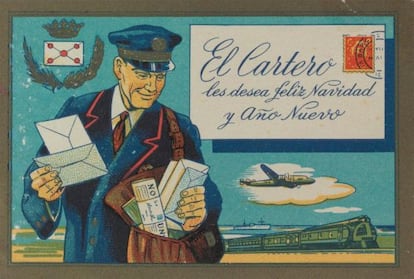Sounding the last post for the letter
National Library’s new show looks at five centuries of written correspondence


The letter is in its death throes — perhaps it is already dead. Or perhaps not: nostalgia is, after all, a powerful force. But even if it does manage to hold out somewhere, its heyday is certainly over. So says Antonio Castillo, associate professor of the history of written culture at the University of Alcalá de Henares. “It has disappeared as we knew it and has been substituted by another form of epistolary communication.”
Now Spain’s National Library (BNE) is remembering the glory days of written correspondence in the exhibition Me alegraré que al recibo de esta. Cinco siglos escribiendo cartas (or, I’ll be pleased when you receive this. Five centuries writing letters). The show includes mail from the likes of mystic Teresa of Ávila, Socialist Party founder Pablo Iglesias and the writers Francisco de Quevedo, Federico García Lorca and Ramón del Valle Inclán, as well as coded letters, treatises on handwriting, postcards, letters to the Three Kings (Spain’s equivalent of Father Christmas), letters of condolence and congratulation, and missives from prisoners condemned to death after the Civil War.
“There are those who consider emails and SMS the heirs of the old epistolary culture,” Castillo, together with Carmen Serrano and Verónica Sierra, writes in the exhibition catalogue. “Others, however, resist establishing a direct relationship between these messages, which only exist via a screen, and letters, which have always survived the death of the media that have accommodated them (from wood, slate, mud and stone to papyrus and paper).”
He explains that although the first letters were sent between pharaohs and Babylonian kings in the second millennium BC, their heyday began in the 16th century as literacy grew and Spanish military conflicts around Europe and the colonization of America necessitated communication. The other popularizing factor was the creation of a network to distribute them. In the modern era, the letter became the communication medium par excellence. But it has waned since the 1980s, resulting in the death throes of today.
Tu suscripción se está usando en otro dispositivo
¿Quieres añadir otro usuario a tu suscripción?
Si continúas leyendo en este dispositivo, no se podrá leer en el otro.
FlechaTu suscripción se está usando en otro dispositivo y solo puedes acceder a EL PAÍS desde un dispositivo a la vez.
Si quieres compartir tu cuenta, cambia tu suscripción a la modalidad Premium, así podrás añadir otro usuario. Cada uno accederá con su propia cuenta de email, lo que os permitirá personalizar vuestra experiencia en EL PAÍS.
¿Tienes una suscripción de empresa? Accede aquí para contratar más cuentas.
En el caso de no saber quién está usando tu cuenta, te recomendamos cambiar tu contraseña aquí.
Si decides continuar compartiendo tu cuenta, este mensaje se mostrará en tu dispositivo y en el de la otra persona que está usando tu cuenta de forma indefinida, afectando a tu experiencia de lectura. Puedes consultar aquí los términos y condiciones de la suscripción digital.
Últimas noticias
Most viewed
- Alain Aspect, Nobel laureate in physics: ‘Einstein was so smart that he would have had to recognize quantum entanglement’
- David King, chemist: ‘There are scientists studying how to cool the planet; nobody should stop these experiments from happening’
- Maps of the US attack on Venezuela: Targets, airspace and deployed fleet
- Key points of the military attack on Venezuela: Early morning bombings and a ‘captured’ president
- Trump says Washington will control Venezuela until there is ‘a safe transition’








































